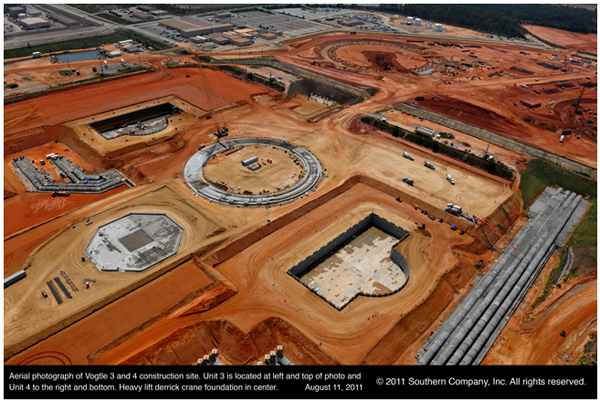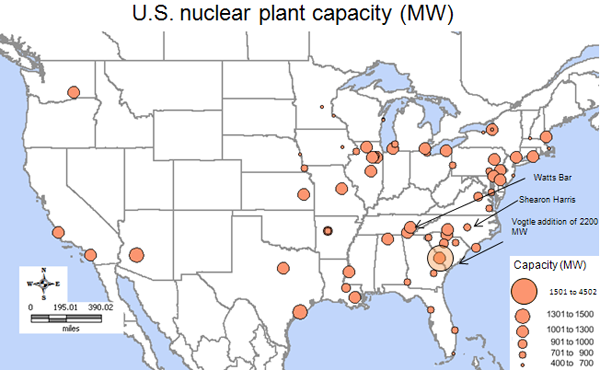
Nuclear Regulatory Commission approves construction of first nuclear units in 30 years

On February 9, the U.S. Nuclear Regulatory Commission (NRC) voted to approve Southern Company's application to build and operate two new nuclear reactors, Units 3 and 4, at its Vogtle plant, near Augusta, Georgia, which already houses two operating reactors. The combined construction and operating license (COL) will make the Vogtle units the first to receive construction approval in over 30 years. The photo above illustrates site preparation work completed as of August 2011. The circular structure in the center of the photo is the foundation for the crane that will support construction of the Units 3 and 4 nuclear islands (above left and below right), which will include the reactor containments.
Of the 104 operating nuclear power reactors in the United States:
- The last construction permit for a nuclear power plant was issued in 1978 for Progress Energy Inc.'s Shearon Harris plant, near Raleigh, North Carolina.
- The last operating license for a nuclear power plant was issued in 1996 to the Tennessee Valley Authority's Watts Bar Unit 1, near Spring City, Tennessee after initial construction began in 1973.

Southern Company applied for the Vogtle COL in March 2008. It was the first application to be based on the Westinghouse Advanced Passive 1000 (AP1000) pressurized water reactor design, which was certified by the NRC on December 22, 2011. Each Vogtle reactor will have a capacity of 1,100 MWe.
The U.S. Department of Energy in February 2010 conditionally approved an $8.3 billion loan guarantee to help the company build the two reactors, which, according to Southern Company's estimates, are expected to cost $14 billion. The Georgia Public Service Commission certified a cost of $6.1 billion to be covered by Southern Company subsidiary Georgia Power for the construction of the new units. The commission certified the construction of this project in 2009 and requires semi-annual monitoring reports. Southern Company and its partners have spent hundreds of millions of dollars on site preparation since the Early Site Permit and Limited Work Authorization were issued in August of 2009.
The AP1000 design includes passive safety features intended to function automatically and even with the loss of on-site power. The passive design features permit the core, containment, and spent fuel pool to be cooled for three days without operator action. Cooling can be continued for up to seven days with only minimal operator action. These features would provide enhanced safety margins and would permit the nuclear power plant to withstand an extended station blackout, such as that at Fukushima.
The NRC's decision will result in the first test of its streamlined licensing process, whereby a combined construction and conditional operating license is issued. Until now, the licensing process involved obtaining a separate construction permit and operating license. This two-step process often resulted in significant construction and operations delays, with resulting higher costs for new nuclear power plants. The NRC will authorize the operation of the Vogtle units once construction and inspections, tests, and analyses are complete and when all acceptance criteria are met. Southern Company expects Vogtle Units 3 and 4 to be operational in 2016 and 2017, respectively.
The construction of the Vogtle units is expected to benefit from China's experience in constructing and operating the AP1000 reactor. China is well along in construction of four AP1000 reactors, the first of which is scheduled to be operational in 2013.
The NRC also is considering SCANA Corporation's application to build two new AP1000 reactors, Virgil C. Summer Units 2 and 3, about 20 miles northwest of Columbia, South Carolina. If approved, Summer 2 and 3 would be operational in 2016 and 2019, respectively. EIA's Reference case for the Annual Energy Outlook 2012 includes the projected operation of the new Vogtle and Summer units. The Reference case also includes completion of TVA's Watts Bar 2 nuclear unit (now under construction after a long hiatus) and completion of TVA's partially-built Bellefonte 1 unit, both near Knoxville, Tennessee (where construction has not yet resumed). The Reference case also projects approximately 7.3 gigawatts of nuclear unit uprates between now and 2035, as well as projected retirements of approximately 6.1 gigawatts of existing nuclear capacity by that date.